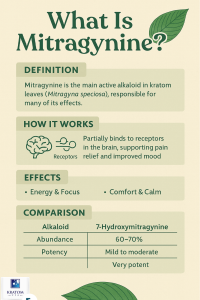🌿 Understanding the Main Active Alkaloid in Kratom
Kratom (Mitragyna speciosa) has gained widespread attention for its unique ability to provide natural relief, energy, and relaxation — all depending on the dose and strain. At the heart of kratom’s effects lies a single powerful compound: mitragynine.
This naturally occurring alkaloid is the primary active ingredient in kratom leaves and is responsible for most of its physical and mental benefits. But what exactly is mitragynine, how does it work, and what makes it different from other plant alkaloids?
Let’s explore the science and safety behind this fascinating compound.
🔑 Key Points
-
Mitragynine is the main alkaloid found in kratom leaves.
-
It interacts with the body’s receptors to support pain relief, focus, calm, energy, and mood support.
-
Unlike opioids, it does not suppress breathing and has a safer, partial-binding effect.
-
A smaller secondary alkaloid, 7-hydroxymitragynine, is more potent but occurs naturally in very low amounts.
-
Lab-tested kratom products ensure consistent alkaloid content and safety.
🧪 What Exactly Is Mitragynine?
 Mitragynine is one of over 40 naturally occurring alkaloids found in the leaves of Mitragyna speciosa, a tree native to Southeast Asia. It typically makes up 60–70% of the total alkaloid content in most kratom strains.
Mitragynine is one of over 40 naturally occurring alkaloids found in the leaves of Mitragyna speciosa, a tree native to Southeast Asia. It typically makes up 60–70% of the total alkaloid content in most kratom strains.
Chemically, mitragynine belongs to a group called indole alkaloids, which are also found in plants like coffee and yohimbe. This explains why kratom is part of the coffee family (Rubiaceae) — not the opium family as many mistakenly believe.
Mitragynine is known for producing both stimulating and relaxing effects, depending on the strain and dosage. At lower doses, it tends to be more energizing and uplifting; at higher doses, it produces calm, relief, and relaxation.
⚙️ How Mitragynine Works in the Body
Mitragynine works by binding partially to certain receptor sites in the brain — primarily mu-opioid receptors, which regulate pain and mood. Unlike opioids, mitragynine acts as a partial agonist, meaning it binds gently without fully activating or blocking these receptors.
This unique mechanism gives kratom its dual nature:
-
Low doses: light stimulation, focus, motivation.
-
Moderate to higher doses: soothing relief, calmness, and improved comfort.
Importantly, mitragynine does not cause respiratory depression, which is the primary danger associated with opioid use. This makes it far less likely to cause overdose-related complications.
🌱 Mitragynine vs. 7-Hydroxymitragynine
While mitragynine is the most abundant alkaloid in kratom, 7-hydroxymitragynine is another key compound often discussed. However, it’s present in very small amounts — usually less than 0.02% of the leaf.
Here’s how the two differ:
| Alkaloid | Abundance | Potency | Function |
|---|---|---|---|
| Mitragynine | 60–70% of alkaloids | Mild to moderate | Balanced energy and relief |
| 7-Hydroxymitragynine | <0.02% | Much stronger | Short-term, fast relief |
Most of the effects users feel come from mitragynine, not 7-hydroxymitragynine. In fact, when kratom is properly dried and processed, the ratio between the two alkaloids helps determine the strain’s strength and effects.
That’s why lab-tested kratom is so important — it confirms the natural balance of alkaloids without synthetic manipulation.
🔬 The Importance of Lab-Tested Kratom
Because alkaloid content can vary by region, harvest time, and drying methods, third-party lab testing is essential to ensure product consistency, safety, and purity.
At KratomUSA, every batch is:
-
Independently tested for mitragynine and 7-hydroxymitragynine content.
-
Screened for contaminants like heavy metals and pathogens.
-
Guaranteed pure — with no synthetic enhancement or adulteration.
This level of transparency ensures customers experience authentic, natural kratom effects exactly as nature intended.
💡 Why Mitragynine Matters
Mitragynine is what makes kratom such a versatile botanical. Its effects span from mild stimulation to soothing comfort — all in a plant that’s been used safely for centuries.
-
It supports daily focus and motivation in small amounts.
-
It offers calm and relief when you need to unwind.
-
It acts as a natural bridge for those seeking balance without pharmaceuticals.
For anyone curious about kratom’s unique benefits, understanding mitragynine is the key to understanding how this remarkable plant works.
🗣️ What Real Users Say
“Kratom has been my go-to for natural relief. I love knowing exactly what’s in my product thanks to KratomUSA’s lab testing.” — Melissa G.
“Understanding mitragynine helped me choose the right strain and dosage. I feel focused during the day and relaxed at night.” — Evan R.
“It’s amazing that a plant can do this without the harsh side effects of pharmaceuticals.” — Lauren S.
❓ FAQ
Q: Is mitragynine an opioid?
A: No. It interacts with similar receptors but does not come from the opium plant and does not suppress breathing.
Q: What does mitragynine do in the body?
A: It partially binds to receptors that influence pain and mood, promoting natural comfort and calm.
Q: Is mitragynine safe?
A: When used responsibly and purchased from lab-tested sources like KratomUSA, mitragynine is considered safe for adult use.
Q: How much mitragynine is in kratom?
A: Typically between 1–2% by weight of dried leaf, though potency varies by strain and harvest.
Q: Does drying or processing affect mitragynine?
A: Yes. Sun-drying and fermentation can slightly alter alkaloid ratios, which is why strain types (red, green, white) have distinct effects.
🌿 Final Thoughts
Mitragynine is the cornerstone alkaloid that gives kratom its unique, balanced effects — from gentle energy to deep relaxation. Understanding how it works helps consumers choose the right strain and dose for their needs.
When sourced from lab-tested, third-party verified suppliers like KratomUSA, mitragynine delivers safe, reliable, and natural results that honor both science and tradition.
For those seeking a plant-based path to wellness, mitragynine is more than an alkaloid — it’s the science behind kratom’s centuries-old reputation for comfort, focus, and balance.



Trackbacks/Pingbacks